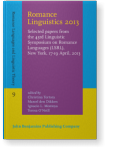Gender agreement with animate nouns in French
Tabea Ihsane | Département de Linguistique, Faculté des Lettres, Université de Genève
Petra Sleeman | Department of Linguistics, University of Amsterdam
Grammatical gender and semantic gender do not always go hand in hand. In French such mismatches can be observed outside the strict DP. To account for such phenomena and for gender more generally, we propose that gender is expressed in two positions within DP: on N as an uninterpretable feature accounting for grammatical gender and on the head of a Gender Phrase as a feature accounting for semantic gender. To account for the mismatches we discuss, we propose that the gender of the nouns involved is unspecified inside DP and that it can be specified in D later in the derivation.We further show that inside the strict DP, grammatical gender agreement between Gen and NP is stricter than in the ‘looser’ DP (partitive), which is in turn stricter than the agreeing/referring relation with elements outside DP, reflecting Corbett’s agreement hierarchy, to which we add a partitive position.
References (23)
References
Alexiadou, Artemis. 2004. “Inflection Class, Gender and DP-internal Structure.” Explorations in Nominal Inflection ed. by Gereon Muller, et al., 21–50. Berlin: Mouton. 

Carstens, Vicki. 2000. “Concord in Minimalist Theory.” Linguistic Inquiry 31.319–355. 

Chomsky, Noam. 2000. “Minimalist Inquiries: the Framework.” Step by Step: Essays on Minimalist Syntax in Honor of Howard Lasnik ed. by Roger Martin, David Michaels and Juan Uriagereka, 89–155. Cambridge, MA: MIT Press.
Chomsky, Noam. 2001. “Derivation by Phase.” Ken Hale: A Life in Language ed. by Michael Kenstowicz, 1–52. Cambridge, MA: MIT Press.
Corbett, Greville. 1979. “The Agreement Hierarchy.” Journal of Linguistics 15.203–224. 

Corbett, Greville. 2003. “Agreement: Terms and Boundaries.” The Role of Agreement in Natural Language: TLS 5 Proceedings ed. by William E. Griffin, 109–122. Texas Linguistics Forum, 53.
Frampton, John and Sam Gutmann. 2000. “Agreement is Feature Sharing.” Ms. Northeastern University. Boston. [URL].
Harris, James. 1991. “The Exponence of Gender in Spanish.” Linguistic Inquiry 22.27–62.
Hinzen, Wolfram. 2012. “Phases and Semantics.” Phases: Developing the Framework ed. by Ángel J. Gallego, 309–342. Berlin & Boston: Walter de Gruyter. 

Kramer, Ruth. 2009. Definite Markers, Phi-features and Agreement: A Morphosyntactic Investigation of the Amharic DP. Ph.D. dissertation, UC Santa Cruz.
Legate, Julie Anne. 2002. “Phases in ‘beyond Explanatory Adequacy’.” Ms., MIT.
Leslau, Wolf. 1995. Reference Grammar of Amharic. Wiesbaden: Harrassowitz.
Lowenstamm, Jean. 2008. “On Little n, √, and Types of Nouns.” Sounds of Silence: Empty Elements in Syntax and Phonology ed. by Jutta Hartmann, Veronika Hegedus and Henk van Riemsdijk 105–144. Amsterdam: Elsevier.
Percus, Orin. 2011. “Gender Features and Interpretation: A case study.” Morphology 21.167–196. 

Picallo, Carmen. 1991. “Nominals and Nominalizations in Catalan.” Probus 3.279–316. 

Preminger, Omer. 2009. “Breaking Agreements: Distinguishing Agreement and Clitic Doubling by their Failures.” Linguistic Inquiry 40:4.619-666. 

Preminger, Omer. 2011. Agreement as a Fallible Operation. Ph.D. dissertation, MIT.
Rey-Debove, Josette and Alain Rey. 2010. Le Nouveau Petit Robert de la Langue Française. Paris: Dictionnaires le Robert.
Ritter, Elisabeth. 1993. “Where’s Gender?” Linguistic Inquiry 24:3.795–803.
Yatsushiro, Kazuko and Uli Sauerland. 2006. “[Feminine] in a High Position.” Snippets 13.11–12.
Cited by (1)
Cited by one other publication
Zanoli, Emma
2022.
A Linguistic Perspective on Feminisation and Gender-Inclusive Language
How Partitive Constructions Can Be Used to Uncover Implicit Gender Bias in Italian
.
Annali di Ca’ Foscari. Serie occidentale :56

This list is based on CrossRef data as of 25 july 2024. Please note that it may not be complete. Sources presented here have been supplied by the respective publishers.
Any errors therein should be reported to them.
